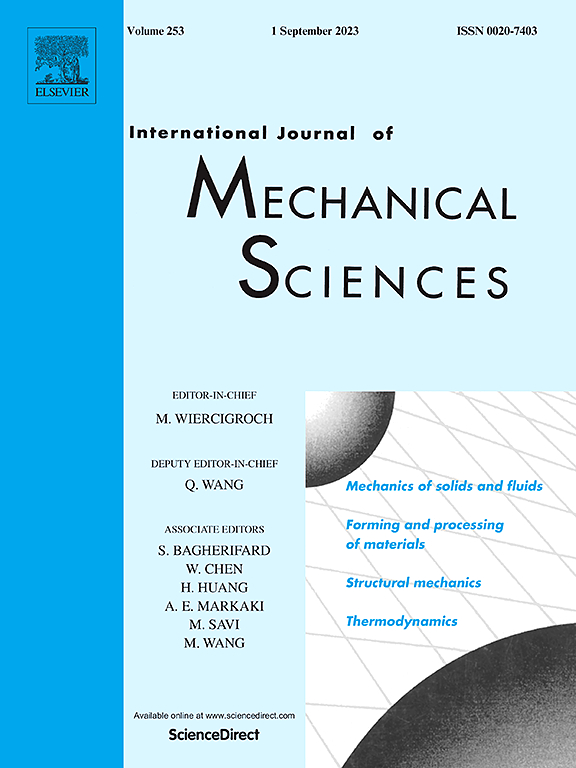Multiparameter vibration isolator with magnetic inerter and GER-control
IF 7.1
1区 工程技术
Q1 ENGINEERING, MECHANICAL
International Journal of Mechanical Sciences
Pub Date : 2025-04-25
DOI:10.1016/j.ijmecsci.2025.110307
引用次数: 0
Abstract
Traditional passive vibration isolators (VIs) suppress resonance by increasing damping or introducing an inerter. However, they suffer from degraded high-frequency isolation owing to the water bed effect. This paper presents a multiparameter VI with magnetic inerter-based damping (MID) that achieves passive sky-hook damping through the purely mechanical configuration of a magnetic lead screw (MLS). The MLS serves simultaneously as a nonlinear inerter and a frequency-dependent damper, producing experimentally validated damping characteristics with 43.0 % lower peak transmissibility (10.78 dB) compared to conventional two-parameter VIs (18.91 dB), while preserving a −40 dB/dec high-frequency roll-off. Theoretical modelling quantitatively explains these frequency-dependent damping features. Furthermore, a frequency-adaptive control method that enables real-time co-regulation of damping and stiffness via a giant electrorheological (GER) fluid is developed, yielding a 19.41 % additional low-frequency isolation improvement over passive operation. Experimental validation confirmed a 78.31 % isolation efficiency enhancement at the natural frequency of the system with complete suppression of high-frequency vibration amplification compared with conventional two-parameter VIs. Thus, this study establishes a novel multiparameter VI by synergistically integrating a magnetic inerter with GER smart materials.

多参数隔振器与磁干涉和ger控制
传统的被动隔振器(VIs)通过增加阻尼或引入干涉器来抑制共振。然而,由于水床效应,它们的高频隔离度下降。本文提出了一种基于磁干涉阻尼(MID)的多参数VI,该VI通过磁丝杠(MLS)的纯机械结构实现被动天钩阻尼。MLS同时作为非线性干涉器和频率相关阻尼器,与传统的双参数VIs (18.91 dB)相比,MLS产生了实验验证的阻尼特性,峰值透射率(10.78 dB)降低43.0%,同时保持了−40 dB/dec的高频滚降。理论模型定量地解释了这些频率相关的阻尼特性。此外,还开发了一种频率自适应控制方法,通过巨电流变(GER)流体实现阻尼和刚度的实时协同调节,与被动操作相比,低频隔离性能提高了19.41%。实验验证表明,与传统的双参数干涉器相比,该系统在固有频率处的隔离效率提高了78.31%,并且完全抑制了高频振动放大。因此,本研究通过将磁性干涉器与GER智能材料协同集成,建立了一种新型的多参数干涉器。
本文章由计算机程序翻译,如有差异,请以英文原文为准。
求助全文
约1分钟内获得全文
求助全文
来源期刊

International Journal of Mechanical Sciences
工程技术-工程:机械
CiteScore
12.80
自引率
17.80%
发文量
769
审稿时长
19 days
期刊介绍:
The International Journal of Mechanical Sciences (IJMS) serves as a global platform for the publication and dissemination of original research that contributes to a deeper scientific understanding of the fundamental disciplines within mechanical, civil, and material engineering.
The primary focus of IJMS is to showcase innovative and ground-breaking work that utilizes analytical and computational modeling techniques, such as Finite Element Method (FEM), Boundary Element Method (BEM), and mesh-free methods, among others. These modeling methods are applied to diverse fields including rigid-body mechanics (e.g., dynamics, vibration, stability), structural mechanics, metal forming, advanced materials (e.g., metals, composites, cellular, smart) behavior and applications, impact mechanics, strain localization, and other nonlinear effects (e.g., large deflections, plasticity, fracture).
Additionally, IJMS covers the realms of fluid mechanics (both external and internal flows), tribology, thermodynamics, and materials processing. These subjects collectively form the core of the journal's content.
In summary, IJMS provides a prestigious platform for researchers to present their original contributions, shedding light on analytical and computational modeling methods in various areas of mechanical engineering, as well as exploring the behavior and application of advanced materials, fluid mechanics, thermodynamics, and materials processing.
 求助内容:
求助内容: 应助结果提醒方式:
应助结果提醒方式:


